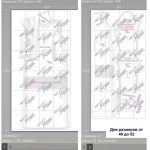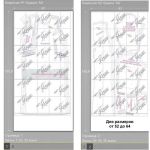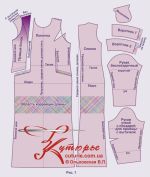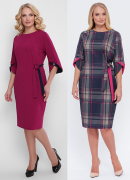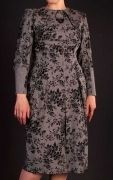Size charts What is the height of the pattern Payment methods Ask a question Reviews
Electronic dress pattern for printing in full size on a printer or plotter. Printed on sheets of paper from A4 to A0.
 Free download Instructions on how to sew a case for a dress pattern
Free download Instructions on how to sew a case for a dress pattern
How to sew a loose sheath dress with a large collar on a pattern with your own hands
Contents of the instruction:
- Description of dress patterns.
- What patterns are included in the set of patterns for the sheath dress.
- Description of the design of the style of the dress and recommended fabrics.
- How to buy and download ready-made dress patterns.
- How to cut a sheath dress according to a finished pattern.
- How to sew a loose sheath dress with a large collar.
Buy and download this dress pattern
1. Description of dress patterns

 Electronic patterns of a free sheath dress with a large collar. Sizes: 40-52 and 52-64.
Electronic patterns of a free sheath dress with a large collar. Sizes: 40-52 and 52-64.
File format: PDF full size and without seam allowances
After paying for the order, you will receive links to download two files dress patterns - a case of a free silhouette with a large collar, gradation of sizes from 40 to 52 and from 52 to 64:
- PDF file A4, adapted for printing patterns on sheets of A4 paper in any program on any device, including mobile phones.
- Multi-format PDF file for printing on sheets of any size from A0 to A4 on a printer or plotter using Adobe Reader.
Pattern assembly diagram when printing on A4 sheets of a home printer
The pattern is assembled on two large pages of patterns from 54 sheets of A4 paper.
1 page of patterns - 30 sheets of A4 paper, 6 rows of 5 sheets in a row.
2 page patterns - 24 sheets of A4 paper 6 rows of 4 sheets in a row
The pattern is assembled on two large pages of patterns from 70 sheets of A4 paper.
1 page of patterns - 35 sheets of A4 paper, 7 rows of 5 sheets in a row.
2 page of patterns - 35 sheets of A4 paper 7 rows of 5 sheets in a row
The sewing difficulty level is medium, for experienced couturiers. You will need confident skills in working with stretch in general and skills in handling pockets; overlock with a knitted line and a machine with an adjustable zigzag.
The style is suitable for all types of figures of any fullness and height.
The pattern is designed for sewing at home on household sewing machines.
2. What patterns are included in the set of patterns for the sheath dress
- Shelf details - shelf and right barrel (shelves).
- Back.
- Sleeves - non-stop under the armhole without a tuck and a narrow sleeve with a fit under the armhole with a tuck.
- Collars - the first with a small flare, the second with a "medium" flare.
- Burlap pocket - under the pocket with a piece of paper.
Details of the bar and leaf are not included in the set of patterns, as they are rectangles. How to cut these details is described below.
3. Description of the design of the style of the dress and recommended fabrics.
3.1. Description of sheath dress loose with big collar
The pattern is made on the basis of a case and has two armhole options - with a tuck for the chest and without a tuck for the chest.
 The detachable right side of the shelf has the same armhole options, only in the version of the armhole with a tuck, the tuck of the barrel is closed - transferred to a semi-relief.
The detachable right side of the shelf has the same armhole options, only in the version of the armhole with a tuck, the tuck of the barrel is closed - transferred to a semi-relief.
The cut is asymmetric: on the right - a semi-relief, on the left - a tuck located symmetrically to the semi-relief.
Sp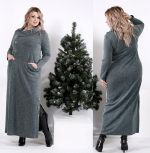 an inca with a middle seam makes it easy to adapt the pattern to any curves of the back and remove excessive looseness in the waist area.
an inca with a middle seam makes it easy to adapt the pattern to any curves of the back and remove excessive looseness in the waist area.
The length is maximum. The length correction area is located above a slight expansion along the side and middle seams.
Sleeves are designed for both armholes.
The collars have a "pocket allowance".
3.2. What to sew a free sheath dress from
For this model, they are suitable as knitted fabrics with a small and medium stretch.
Only very loose and thick knitwear imitating hand knitting will not work.
Fabric consumption with a width of 150 cm will be from 210 to 270 cm.
4. How to buy and download ready-made dress patterns
How to choose a size without using tables and taking measurements
What height are the patterns for?
How to buy a ready-made electronic pattern
How to print a pattern at home in full size on A4 sheets or on sheets of any other size
How to assemble a pattern after printing
Simple patterns for dresses, sweatshirts, skirts and trousers in full size Free
Buy and download this dress pattern
5. How to cut a sheath dress according to a finished pattern
- Choose an armhole, sleeve and collar option;
- Decide whether you need a strap and a slot or you will replace them with zippers;
- Change the length of the dress pattern, taking into account the hem, if necessary, by laying folds in the correction zone or by making a cut and glue a strip of paper.
Let's consider one of the simple options for cutting from stretch knitted fabric with sewing "on the overlock".
In this case, add only 0,5 cm for the seams. The usual exceptions for armholes, necklines, and rims can be ignored.
As mentioned earlier, the detail of the pockets, called the leaflet, and the details of the slats are rectangles (strips of fabric). Their optimal width in finished form is 2,5 - 3 cm. 3 cm is included in the marking of the pockets on the pattern.
To simplify the cutting of these parts, we cut out strips 2,5 - 3 cm wide from the “doubler for stretch fabrics”.
The length of the strip for the leaflet = The length of the leaflet, measured according to the pattern + 5 cm
Plank strip length = Plank length measured from the pattern + 4 cm
The stock in length will facilitate the processing of pockets and slats. Excess during processing can be cut off with an overlock when overcasting the corresponding cuts or with scissors.
Dublerin blanks can be put aside and proceed with the layout.
One of the layout options for small sizes is shown in 2 drawing. Larger sizes will require a “jack” layout (the backs are turned “upside down”), there are no other differences.
The fabric is spread in one layer right side up, as the cut is asymmetrical.
Patterns are laid out in accordance with the desired shared direction in the most economical way.
It is better to postpone the opening of the collar until trying on and / or until the moment when the half-relief fastener and shoulder seams are processed.
After cutting out large parts, you can decompose and stick blanks from dublerin on lunges. The strips are located along the lobar thread.
Please note that the leaflets and slats must be doubled, as shown in 2 drawing.
If you process the slot, as shown in the photo, you should add an allowance for the slots for a hem of 3 - 3,5 cm to the right side cut.
Should I add an allowance for the headband under the bar in a semi-relief? Not necessary. The pick-up can be processed with a shared inlay. If the semi-relief fastener is with a zipper, you can even do without an inlay. In a word, processing depends on the thickness of the fabric and your intention.
At the end of the cutting, perform notches and markings:
- Along the side seam, folding all four side cuts together - notches at the waist and along the hips. On the detail of the barrel - a notch at the waist.
- Sew along the middle seam of the back at the waist.
- Mark the lines "the line of entry into the pocket, the fold of the leaflet" - they are marked on the drawing of the shelf.
- Mark the half-skid with a slip stitch - large stitches by hand or machine basting.
- Make a cut along the "cut" line on the left side of the front and cut the tuck to the waist.
- Notches in the corners "half-relief-cut" and "tuck-cut" can be made later, during the sewing process.
6. How to sew a loose sheath dress with a large collar
Before you start sewing, adjust the knitted seam on the overlocker and decide what machine stitches will you use for sewing knitwear
- The beginning of sewing is to iron along, folding the blanks of the strips and the leaflet in half.
- Sew and overcast the plank along the semi-relief, make a notch in the corner and sew the plank to the left side seam of the back.
- Stitch the leaves in a narrow zigzag to the lines of attaching the leaves, do not overcast, notch in the left corner (“tuck-cut” corner).
- Stitch the burlap in a narrow zigzag pattern to the seam of the leaflet and stitch the burlap to the second section, labeled "cut". Sweep and iron.
- Baste or pin the fold of the leaflet to the “pocket entry line” that you marked out.
- Process the semi-relief and tuck. Iron.
- Sweep or chop off the burlap, grind it down, trim (that is, cut) mismatched cuts and overcast on the overlock. Experienced tailors can overcast burlap immediately without trimming the excess. Iron.
- We grind the shoulder seams on the overlock, placing a stretch edge (1,5 cm strip). The seam should remain elastic, but stretch a little less than it is due to the properties of the fabric. Stable strips and tape are not suitable, as the seam will look tight compared to the front over time. Iron the seam.
- Sew sleeve on overlocker , distributing the eyelet evenly along the armhole and iron the seam.
- Then everything is simple - we grind the middle seam of the back on the overlock and the side seams too, iron it.
- We process the slot.
- You can try on.
- Based on the length of the neck, cut out the collar. You can not look at the size figure - it is the length of the neck that is important.
- Whether to duplicate the collar depends on the properties of the fabric and your design. If necessary, duplicate with a stretch doubler. We grind.
- We sew the lower collar, distributing it evenly over the neck. Please note: the neckline is asymmetric and the middle line of the collar pattern does NOT match the middle seam of the back. The collar is designed in such a way that the middle line is not important. We iron the stitching seam.
- We lay a line in the seam of attaching the collar and overcast the cut. For a cleaner finish, the open cut of the top collar can be folded over or finished in another way.
- Remain the bottom of the dress and the bottom of the sleeve. They are processed into a hem with an open cut - overcast and fold once, iron. For a clean finish, you can use a twin needle as an imitation of a cover stitch.
Download this pattern pdf:
Patterns of a loose sheath dress with a large collar
$2.50 (100 hryvnia)
Bank cards of the Russian Federation are not accepted for payment!
Size charts What is the height of the pattern Payment methods Ask a question Reviews
Vera Olkhovskaya in social networks:

See similar clothing patterns and how to sew on them
-
Any pattern for free for a review of a previously made order
More...
Lifetime promotion for buyers of patterns!

Leave a review about my store of patterns for an order that you made before, and you will receive any paid pattern of your choice Free!

 Buy and download PDF dress pattern
Buy and download PDF dress pattern